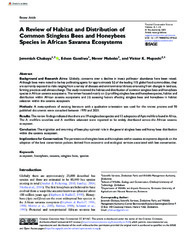A Review of Habitat and Distribution of Common Stingless Bees and Honeybees Species in African Savanna Ecosystems.
Date
2022-05-03Author
Chakuya, Jeremiah
Gandiwa, Edson
Muboko, Never
Muposhi, Victor K.
Metadata
Show full item recordAbstract
Background and Research Aims: Globally, concerns over a decline in insect pollinator abundance have been raised. Although bees were noted to be key pollinating agents for approximately 52 of the leading 115 global food commodities, they are currently exposed to risks ranging from a variety of diseases and environmental threats emanating from changes in land use, farming practices and climate change. The study reviewed the habitat and distribution of common stingless bees and honeybees species in African savanna ecosystems. The review focused mainly on (i) profiling stingless bee and honeybee species, habitat and distribution within African savanna ecosystems and (ii) assessing factors affecting stingless bees and honeybees in habitat selection within the savanna ecosystem. Methods: A meta-synthesis of existing literature with a qualitative orientation was used for the review process and 90 published documents were consulted between 1970 and 2021. Results: The review findings indicated that there are 19 stingless bee species and 13 subspecies of Apis mellifera found in Africa. The A. mellifera scutellata and A. mellifera adansonii were reported to be widely distributed across the African savanna ecosystem. Conclusion: The migration and swarming of bees play a pivotal role in the general stingless bees and honey bees distribution within the savanna ecosystem. Implications for Conservation: The persistence of stingless bees and honeybees within savanna ecosystems depends on the adoption of the best conservation policies derived from economic and ecological services associated with bee conservation.
Collections
- Research articles [88]

